Improving Ask Foods Supply Chain Performance: A Detailed Report
VerifiedAdded on 2022/12/22
|20
|5137
|95
Report
AI Summary
This report provides a comprehensive analysis of Ask Foods' supply chain performance, identifying key challenges and proposing effective solutions. It begins with an executive summary and introduction to the company, detailing its operations in the fruit and vegetable industry and its export-oriented market. The report then describes the current supply chain situation, highlighting the complexities and inefficiencies that hinder its ability to meet growing demand and reduce logistical costs. Several potential solutions are explored, including upstream and downstream supply chain integration, omnichannel systems, cold chain logistics, and the adoption of e-commerce. The report recommends a focus on upstream supply chain management and e-commerce implementation, offering a detailed justification for these choices and outlining the benefits of traceability and improved customer service. An implementation plan is also included, along with a conclusion and recommendations for Ask Foods to optimize its supply chain, enhance its competitive advantage, and meet its business goals.
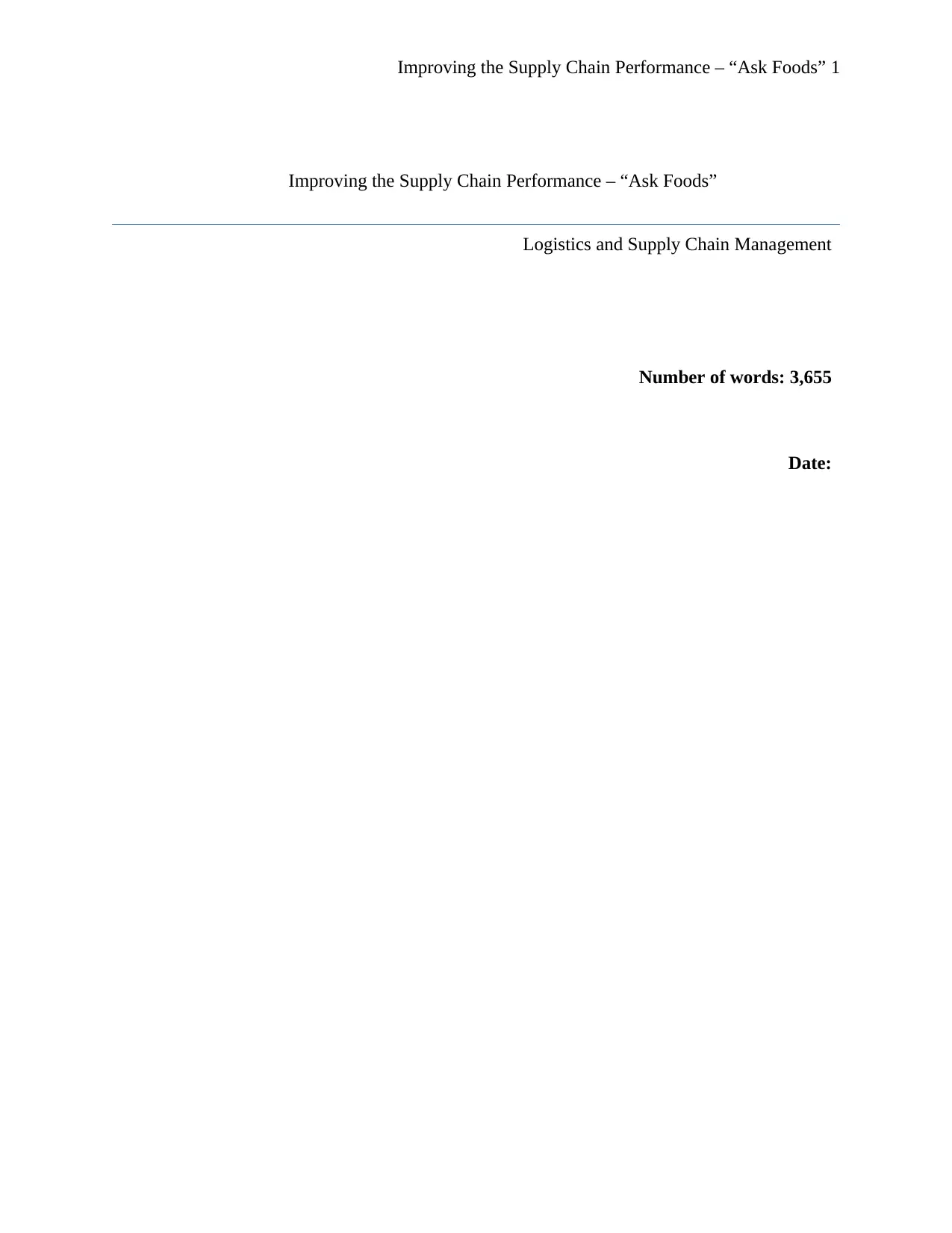
Improving the Supply Chain Performance – “Ask Foods” 1
Improving the Supply Chain Performance – “Ask Foods”
Logistics and Supply Chain Management
Number of words: 3,655
Date:
Improving the Supply Chain Performance – “Ask Foods”
Logistics and Supply Chain Management
Number of words: 3,655
Date:
Paraphrase This Document
Need a fresh take? Get an instant paraphrase of this document with our AI Paraphraser
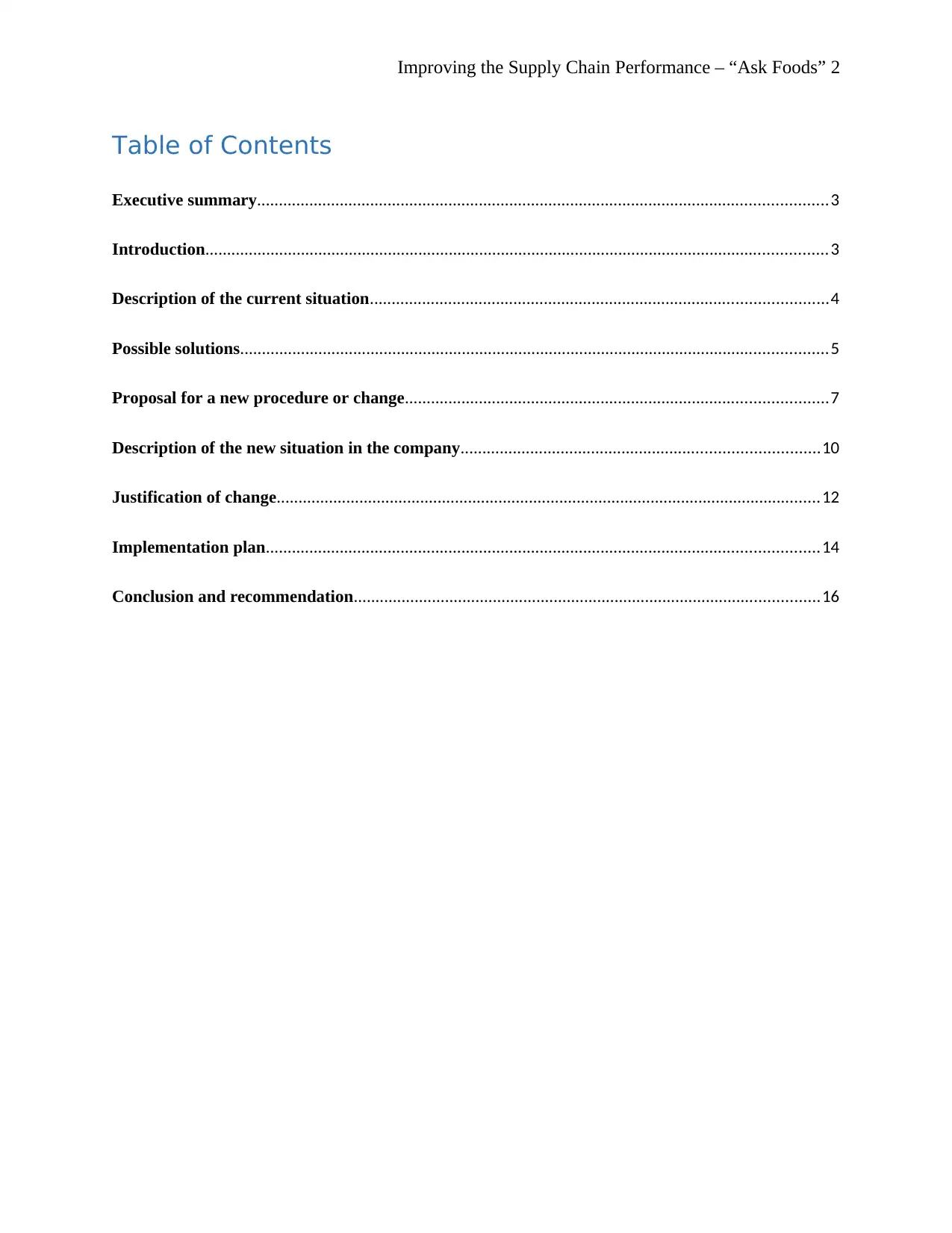
Improving the Supply Chain Performance – “Ask Foods” 2
Table of Contents
Executive summary...................................................................................................................................3
Introduction...............................................................................................................................................3
Description of the current situation.........................................................................................................4
Possible solutions.......................................................................................................................................5
Proposal for a new procedure or change.................................................................................................7
Description of the new situation in the company..................................................................................10
Justification of change.............................................................................................................................12
Implementation plan...............................................................................................................................14
Conclusion and recommendation...........................................................................................................16
Table of Contents
Executive summary...................................................................................................................................3
Introduction...............................................................................................................................................3
Description of the current situation.........................................................................................................4
Possible solutions.......................................................................................................................................5
Proposal for a new procedure or change.................................................................................................7
Description of the new situation in the company..................................................................................10
Justification of change.............................................................................................................................12
Implementation plan...............................................................................................................................14
Conclusion and recommendation...........................................................................................................16
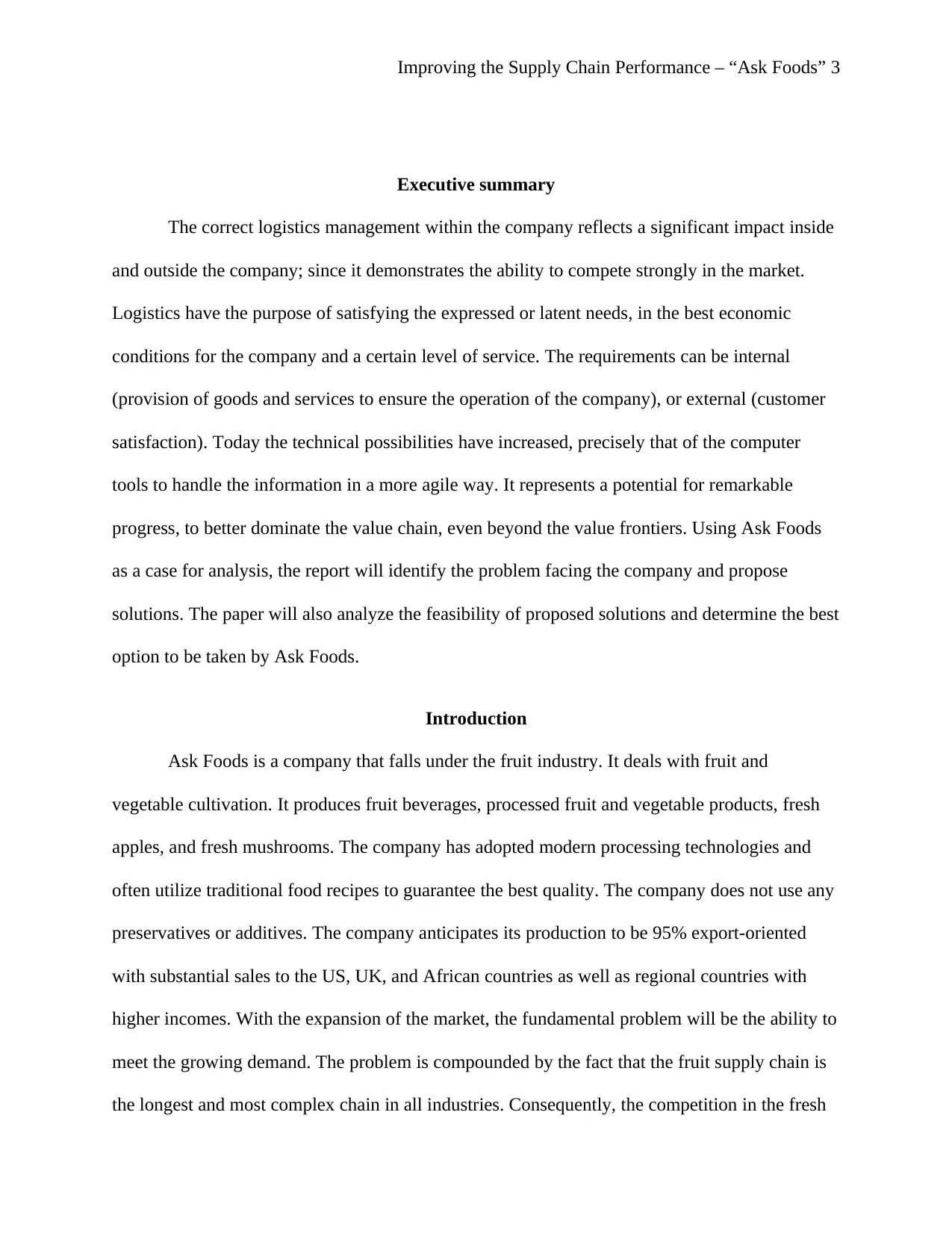
Improving the Supply Chain Performance – “Ask Foods” 3
Executive summary
The correct logistics management within the company reflects a significant impact inside
and outside the company; since it demonstrates the ability to compete strongly in the market.
Logistics have the purpose of satisfying the expressed or latent needs, in the best economic
conditions for the company and a certain level of service. The requirements can be internal
(provision of goods and services to ensure the operation of the company), or external (customer
satisfaction). Today the technical possibilities have increased, precisely that of the computer
tools to handle the information in a more agile way. It represents a potential for remarkable
progress, to better dominate the value chain, even beyond the value frontiers. Using Ask Foods
as a case for analysis, the report will identify the problem facing the company and propose
solutions. The paper will also analyze the feasibility of proposed solutions and determine the best
option to be taken by Ask Foods.
Introduction
Ask Foods is a company that falls under the fruit industry. It deals with fruit and
vegetable cultivation. It produces fruit beverages, processed fruit and vegetable products, fresh
apples, and fresh mushrooms. The company has adopted modern processing technologies and
often utilize traditional food recipes to guarantee the best quality. The company does not use any
preservatives or additives. The company anticipates its production to be 95% export-oriented
with substantial sales to the US, UK, and African countries as well as regional countries with
higher incomes. With the expansion of the market, the fundamental problem will be the ability to
meet the growing demand. The problem is compounded by the fact that the fruit supply chain is
the longest and most complex chain in all industries. Consequently, the competition in the fresh
Executive summary
The correct logistics management within the company reflects a significant impact inside
and outside the company; since it demonstrates the ability to compete strongly in the market.
Logistics have the purpose of satisfying the expressed or latent needs, in the best economic
conditions for the company and a certain level of service. The requirements can be internal
(provision of goods and services to ensure the operation of the company), or external (customer
satisfaction). Today the technical possibilities have increased, precisely that of the computer
tools to handle the information in a more agile way. It represents a potential for remarkable
progress, to better dominate the value chain, even beyond the value frontiers. Using Ask Foods
as a case for analysis, the report will identify the problem facing the company and propose
solutions. The paper will also analyze the feasibility of proposed solutions and determine the best
option to be taken by Ask Foods.
Introduction
Ask Foods is a company that falls under the fruit industry. It deals with fruit and
vegetable cultivation. It produces fruit beverages, processed fruit and vegetable products, fresh
apples, and fresh mushrooms. The company has adopted modern processing technologies and
often utilize traditional food recipes to guarantee the best quality. The company does not use any
preservatives or additives. The company anticipates its production to be 95% export-oriented
with substantial sales to the US, UK, and African countries as well as regional countries with
higher incomes. With the expansion of the market, the fundamental problem will be the ability to
meet the growing demand. The problem is compounded by the fact that the fruit supply chain is
the longest and most complex chain in all industries. Consequently, the competition in the fresh
⊘ This is a preview!⊘
Do you want full access?
Subscribe today to unlock all pages.

Trusted by 1+ million students worldwide
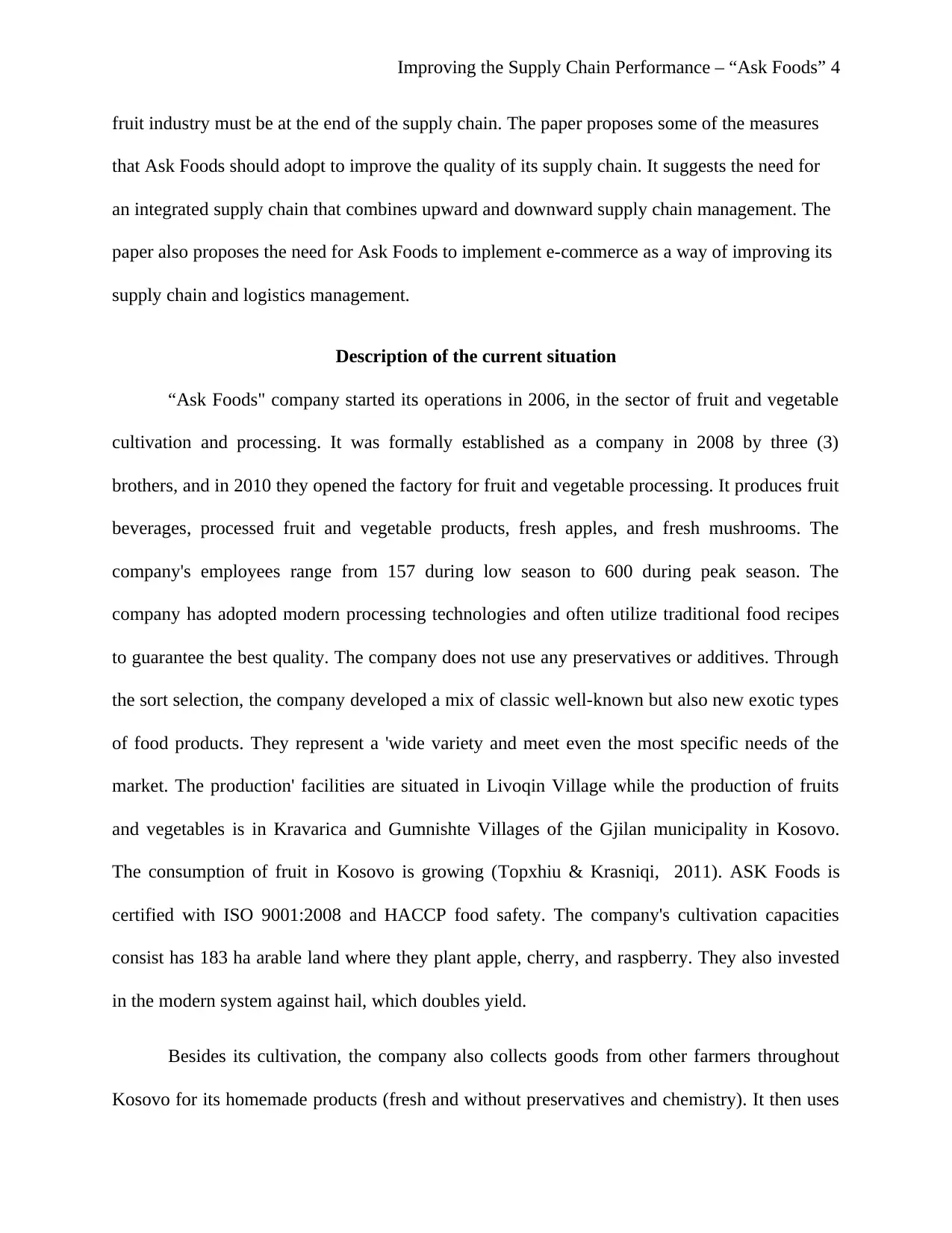
Improving the Supply Chain Performance – “Ask Foods” 4
fruit industry must be at the end of the supply chain. The paper proposes some of the measures
that Ask Foods should adopt to improve the quality of its supply chain. It suggests the need for
an integrated supply chain that combines upward and downward supply chain management. The
paper also proposes the need for Ask Foods to implement e-commerce as a way of improving its
supply chain and logistics management.
Description of the current situation
“Ask Foods" company started its operations in 2006, in the sector of fruit and vegetable
cultivation and processing. It was formally established as a company in 2008 by three (3)
brothers, and in 2010 they opened the factory for fruit and vegetable processing. It produces fruit
beverages, processed fruit and vegetable products, fresh apples, and fresh mushrooms. The
company's employees range from 157 during low season to 600 during peak season. The
company has adopted modern processing technologies and often utilize traditional food recipes
to guarantee the best quality. The company does not use any preservatives or additives. Through
the sort selection, the company developed a mix of classic well-known but also new exotic types
of food products. They represent a 'wide variety and meet even the most specific needs of the
market. The production' facilities are situated in Livoqin Village while the production of fruits
and vegetables is in Kravarica and Gumnishte Villages of the Gjilan municipality in Kosovo.
The consumption of fruit in Kosovo is growing (Topxhiu & Krasniqi, 2011). ASK Foods is
certified with ISO 9001:2008 and HACCP food safety. The company's cultivation capacities
consist has 183 ha arable land where they plant apple, cherry, and raspberry. They also invested
in the modern system against hail, which doubles yield.
Besides its cultivation, the company also collects goods from other farmers throughout
Kosovo for its homemade products (fresh and without preservatives and chemistry). It then uses
fruit industry must be at the end of the supply chain. The paper proposes some of the measures
that Ask Foods should adopt to improve the quality of its supply chain. It suggests the need for
an integrated supply chain that combines upward and downward supply chain management. The
paper also proposes the need for Ask Foods to implement e-commerce as a way of improving its
supply chain and logistics management.
Description of the current situation
“Ask Foods" company started its operations in 2006, in the sector of fruit and vegetable
cultivation and processing. It was formally established as a company in 2008 by three (3)
brothers, and in 2010 they opened the factory for fruit and vegetable processing. It produces fruit
beverages, processed fruit and vegetable products, fresh apples, and fresh mushrooms. The
company's employees range from 157 during low season to 600 during peak season. The
company has adopted modern processing technologies and often utilize traditional food recipes
to guarantee the best quality. The company does not use any preservatives or additives. Through
the sort selection, the company developed a mix of classic well-known but also new exotic types
of food products. They represent a 'wide variety and meet even the most specific needs of the
market. The production' facilities are situated in Livoqin Village while the production of fruits
and vegetables is in Kravarica and Gumnishte Villages of the Gjilan municipality in Kosovo.
The consumption of fruit in Kosovo is growing (Topxhiu & Krasniqi, 2011). ASK Foods is
certified with ISO 9001:2008 and HACCP food safety. The company's cultivation capacities
consist has 183 ha arable land where they plant apple, cherry, and raspberry. They also invested
in the modern system against hail, which doubles yield.
Besides its cultivation, the company also collects goods from other farmers throughout
Kosovo for its homemade products (fresh and without preservatives and chemistry). It then uses
Paraphrase This Document
Need a fresh take? Get an instant paraphrase of this document with our AI Paraphraser
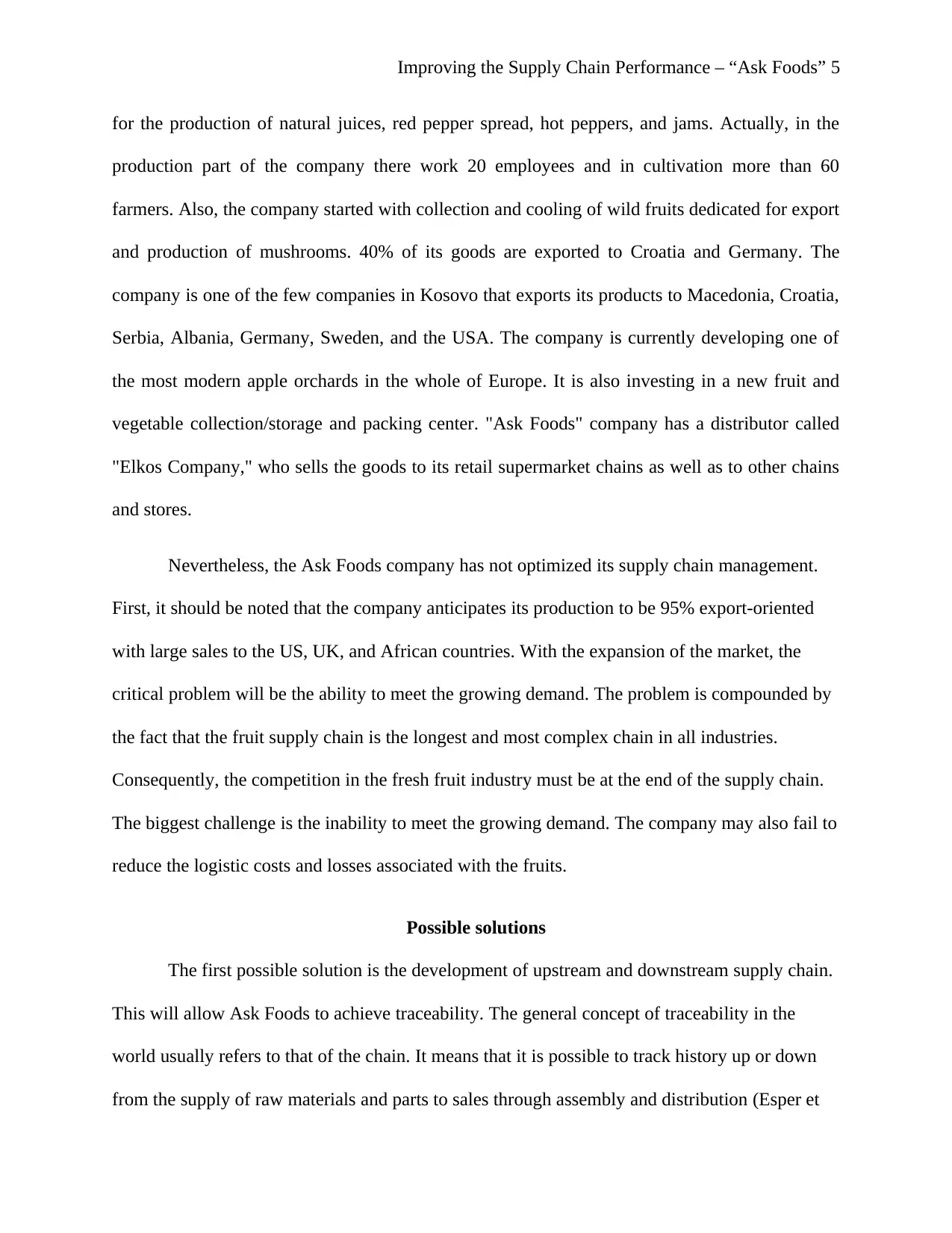
Improving the Supply Chain Performance – “Ask Foods” 5
for the production of natural juices, red pepper spread, hot peppers, and jams. Actually, in the
production part of the company there work 20 employees and in cultivation more than 60
farmers. Also, the company started with collection and cooling of wild fruits dedicated for export
and production of mushrooms. 40% of its goods are exported to Croatia and Germany. The
company is one of the few companies in Kosovo that exports its products to Macedonia, Croatia,
Serbia, Albania, Germany, Sweden, and the USA. The company is currently developing one of
the most modern apple orchards in the whole of Europe. It is also investing in a new fruit and
vegetable collection/storage and packing center. "Ask Foods" company has a distributor called
"Elkos Company," who sells the goods to its retail supermarket chains as well as to other chains
and stores.
Nevertheless, the Ask Foods company has not optimized its supply chain management.
First, it should be noted that the company anticipates its production to be 95% export-oriented
with large sales to the US, UK, and African countries. With the expansion of the market, the
critical problem will be the ability to meet the growing demand. The problem is compounded by
the fact that the fruit supply chain is the longest and most complex chain in all industries.
Consequently, the competition in the fresh fruit industry must be at the end of the supply chain.
The biggest challenge is the inability to meet the growing demand. The company may also fail to
reduce the logistic costs and losses associated with the fruits.
Possible solutions
The first possible solution is the development of upstream and downstream supply chain.
This will allow Ask Foods to achieve traceability. The general concept of traceability in the
world usually refers to that of the chain. It means that it is possible to track history up or down
from the supply of raw materials and parts to sales through assembly and distribution (Esper et
for the production of natural juices, red pepper spread, hot peppers, and jams. Actually, in the
production part of the company there work 20 employees and in cultivation more than 60
farmers. Also, the company started with collection and cooling of wild fruits dedicated for export
and production of mushrooms. 40% of its goods are exported to Croatia and Germany. The
company is one of the few companies in Kosovo that exports its products to Macedonia, Croatia,
Serbia, Albania, Germany, Sweden, and the USA. The company is currently developing one of
the most modern apple orchards in the whole of Europe. It is also investing in a new fruit and
vegetable collection/storage and packing center. "Ask Foods" company has a distributor called
"Elkos Company," who sells the goods to its retail supermarket chains as well as to other chains
and stores.
Nevertheless, the Ask Foods company has not optimized its supply chain management.
First, it should be noted that the company anticipates its production to be 95% export-oriented
with large sales to the US, UK, and African countries. With the expansion of the market, the
critical problem will be the ability to meet the growing demand. The problem is compounded by
the fact that the fruit supply chain is the longest and most complex chain in all industries.
Consequently, the competition in the fresh fruit industry must be at the end of the supply chain.
The biggest challenge is the inability to meet the growing demand. The company may also fail to
reduce the logistic costs and losses associated with the fruits.
Possible solutions
The first possible solution is the development of upstream and downstream supply chain.
This will allow Ask Foods to achieve traceability. The general concept of traceability in the
world usually refers to that of the chain. It means that it is possible to track history up or down
from the supply of raw materials and parts to sales through assembly and distribution (Esper et
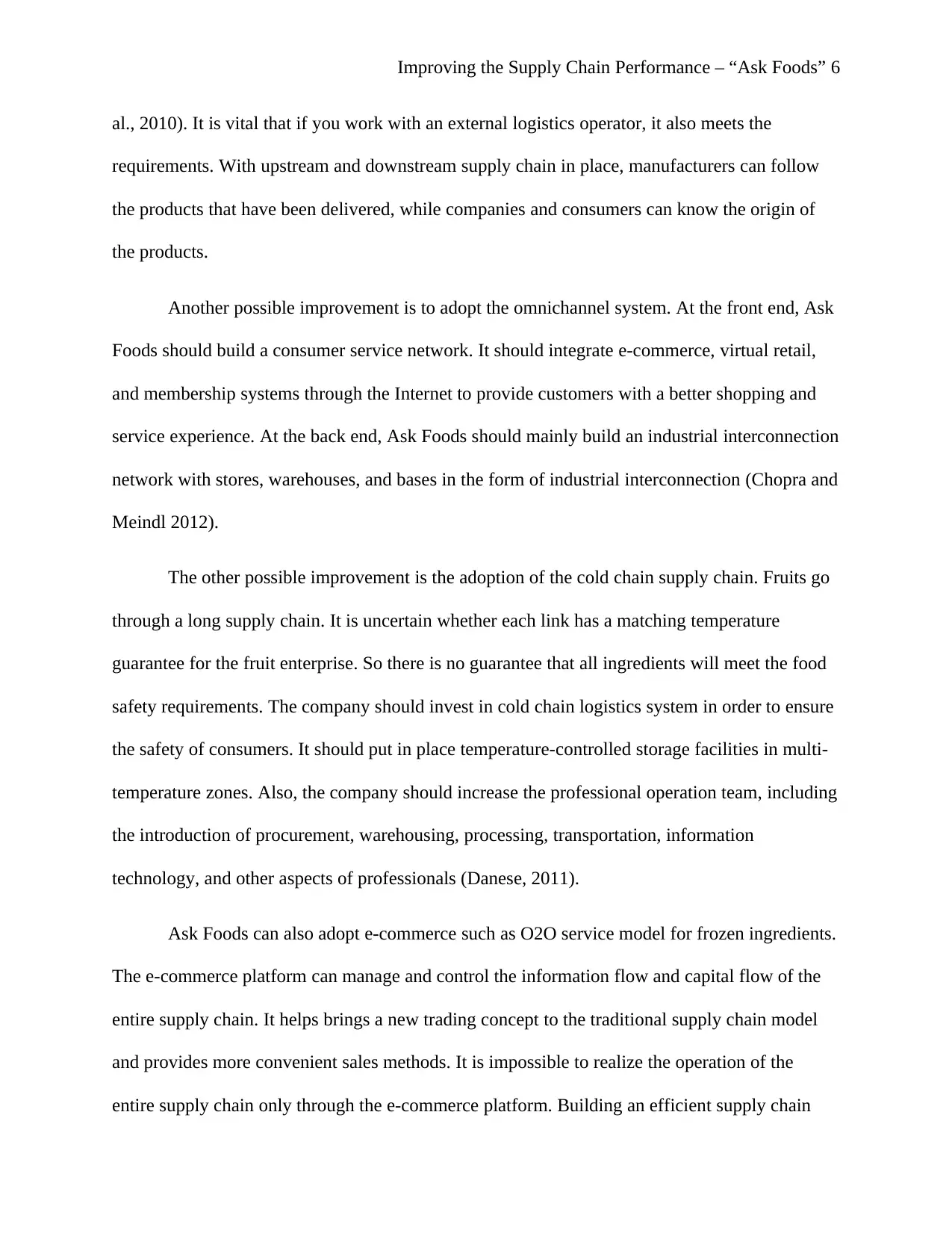
Improving the Supply Chain Performance – “Ask Foods” 6
al., 2010). It is vital that if you work with an external logistics operator, it also meets the
requirements. With upstream and downstream supply chain in place, manufacturers can follow
the products that have been delivered, while companies and consumers can know the origin of
the products.
Another possible improvement is to adopt the omnichannel system. At the front end, Ask
Foods should build a consumer service network. It should integrate e-commerce, virtual retail,
and membership systems through the Internet to provide customers with a better shopping and
service experience. At the back end, Ask Foods should mainly build an industrial interconnection
network with stores, warehouses, and bases in the form of industrial interconnection (Chopra and
Meindl 2012).
The other possible improvement is the adoption of the cold chain supply chain. Fruits go
through a long supply chain. It is uncertain whether each link has a matching temperature
guarantee for the fruit enterprise. So there is no guarantee that all ingredients will meet the food
safety requirements. The company should invest in cold chain logistics system in order to ensure
the safety of consumers. It should put in place temperature-controlled storage facilities in multi-
temperature zones. Also, the company should increase the professional operation team, including
the introduction of procurement, warehousing, processing, transportation, information
technology, and other aspects of professionals (Danese, 2011).
Ask Foods can also adopt e-commerce such as O2O service model for frozen ingredients.
The e-commerce platform can manage and control the information flow and capital flow of the
entire supply chain. It helps brings a new trading concept to the traditional supply chain model
and provides more convenient sales methods. It is impossible to realize the operation of the
entire supply chain only through the e-commerce platform. Building an efficient supply chain
al., 2010). It is vital that if you work with an external logistics operator, it also meets the
requirements. With upstream and downstream supply chain in place, manufacturers can follow
the products that have been delivered, while companies and consumers can know the origin of
the products.
Another possible improvement is to adopt the omnichannel system. At the front end, Ask
Foods should build a consumer service network. It should integrate e-commerce, virtual retail,
and membership systems through the Internet to provide customers with a better shopping and
service experience. At the back end, Ask Foods should mainly build an industrial interconnection
network with stores, warehouses, and bases in the form of industrial interconnection (Chopra and
Meindl 2012).
The other possible improvement is the adoption of the cold chain supply chain. Fruits go
through a long supply chain. It is uncertain whether each link has a matching temperature
guarantee for the fruit enterprise. So there is no guarantee that all ingredients will meet the food
safety requirements. The company should invest in cold chain logistics system in order to ensure
the safety of consumers. It should put in place temperature-controlled storage facilities in multi-
temperature zones. Also, the company should increase the professional operation team, including
the introduction of procurement, warehousing, processing, transportation, information
technology, and other aspects of professionals (Danese, 2011).
Ask Foods can also adopt e-commerce such as O2O service model for frozen ingredients.
The e-commerce platform can manage and control the information flow and capital flow of the
entire supply chain. It helps brings a new trading concept to the traditional supply chain model
and provides more convenient sales methods. It is impossible to realize the operation of the
entire supply chain only through the e-commerce platform. Building an efficient supply chain
⊘ This is a preview!⊘
Do you want full access?
Subscribe today to unlock all pages.

Trusted by 1+ million students worldwide
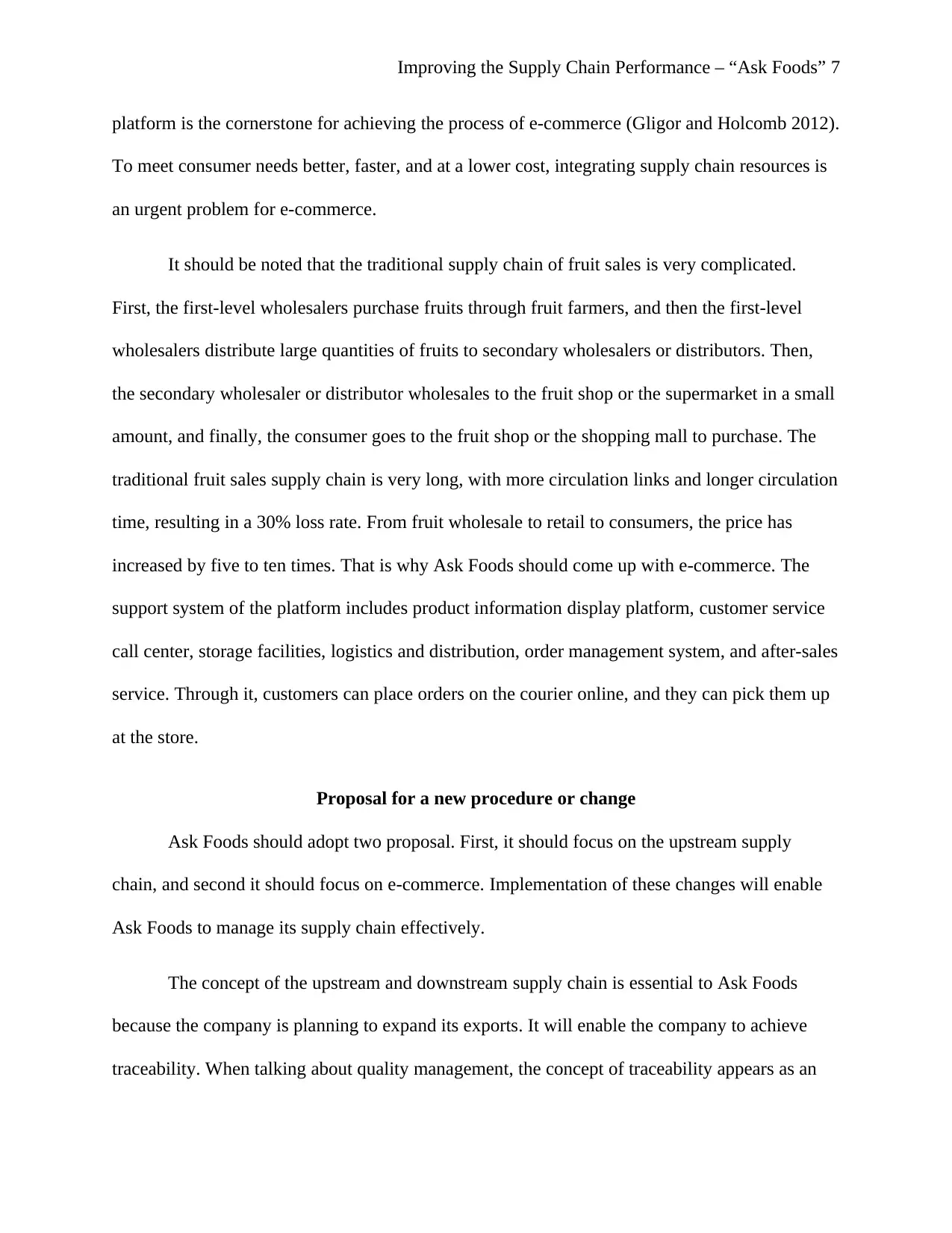
Improving the Supply Chain Performance – “Ask Foods” 7
platform is the cornerstone for achieving the process of e-commerce (Gligor and Holcomb 2012).
To meet consumer needs better, faster, and at a lower cost, integrating supply chain resources is
an urgent problem for e-commerce.
It should be noted that the traditional supply chain of fruit sales is very complicated.
First, the first-level wholesalers purchase fruits through fruit farmers, and then the first-level
wholesalers distribute large quantities of fruits to secondary wholesalers or distributors. Then,
the secondary wholesaler or distributor wholesales to the fruit shop or the supermarket in a small
amount, and finally, the consumer goes to the fruit shop or the shopping mall to purchase. The
traditional fruit sales supply chain is very long, with more circulation links and longer circulation
time, resulting in a 30% loss rate. From fruit wholesale to retail to consumers, the price has
increased by five to ten times. That is why Ask Foods should come up with e-commerce. The
support system of the platform includes product information display platform, customer service
call center, storage facilities, logistics and distribution, order management system, and after-sales
service. Through it, customers can place orders on the courier online, and they can pick them up
at the store.
Proposal for a new procedure or change
Ask Foods should adopt two proposal. First, it should focus on the upstream supply
chain, and second it should focus on e-commerce. Implementation of these changes will enable
Ask Foods to manage its supply chain effectively.
The concept of the upstream and downstream supply chain is essential to Ask Foods
because the company is planning to expand its exports. It will enable the company to achieve
traceability. When talking about quality management, the concept of traceability appears as an
platform is the cornerstone for achieving the process of e-commerce (Gligor and Holcomb 2012).
To meet consumer needs better, faster, and at a lower cost, integrating supply chain resources is
an urgent problem for e-commerce.
It should be noted that the traditional supply chain of fruit sales is very complicated.
First, the first-level wholesalers purchase fruits through fruit farmers, and then the first-level
wholesalers distribute large quantities of fruits to secondary wholesalers or distributors. Then,
the secondary wholesaler or distributor wholesales to the fruit shop or the supermarket in a small
amount, and finally, the consumer goes to the fruit shop or the shopping mall to purchase. The
traditional fruit sales supply chain is very long, with more circulation links and longer circulation
time, resulting in a 30% loss rate. From fruit wholesale to retail to consumers, the price has
increased by five to ten times. That is why Ask Foods should come up with e-commerce. The
support system of the platform includes product information display platform, customer service
call center, storage facilities, logistics and distribution, order management system, and after-sales
service. Through it, customers can place orders on the courier online, and they can pick them up
at the store.
Proposal for a new procedure or change
Ask Foods should adopt two proposal. First, it should focus on the upstream supply
chain, and second it should focus on e-commerce. Implementation of these changes will enable
Ask Foods to manage its supply chain effectively.
The concept of the upstream and downstream supply chain is essential to Ask Foods
because the company is planning to expand its exports. It will enable the company to achieve
traceability. When talking about quality management, the concept of traceability appears as an
Paraphrase This Document
Need a fresh take? Get an instant paraphrase of this document with our AI Paraphraser
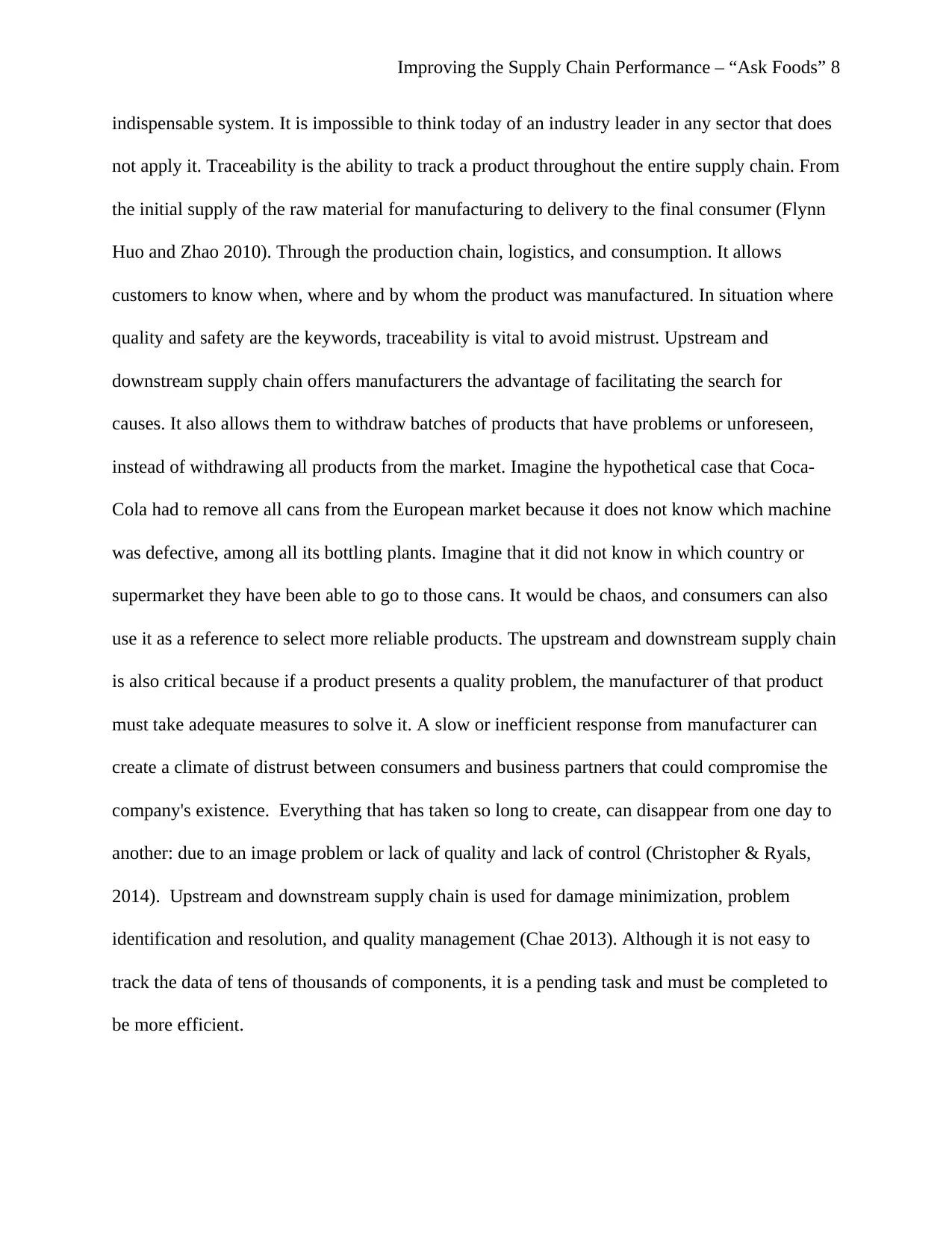
Improving the Supply Chain Performance – “Ask Foods” 8
indispensable system. It is impossible to think today of an industry leader in any sector that does
not apply it. Traceability is the ability to track a product throughout the entire supply chain. From
the initial supply of the raw material for manufacturing to delivery to the final consumer (Flynn
Huo and Zhao 2010). Through the production chain, logistics, and consumption. It allows
customers to know when, where and by whom the product was manufactured. In situation where
quality and safety are the keywords, traceability is vital to avoid mistrust. Upstream and
downstream supply chain offers manufacturers the advantage of facilitating the search for
causes. It also allows them to withdraw batches of products that have problems or unforeseen,
instead of withdrawing all products from the market. Imagine the hypothetical case that Coca-
Cola had to remove all cans from the European market because it does not know which machine
was defective, among all its bottling plants. Imagine that it did not know in which country or
supermarket they have been able to go to those cans. It would be chaos, and consumers can also
use it as a reference to select more reliable products. The upstream and downstream supply chain
is also critical because if a product presents a quality problem, the manufacturer of that product
must take adequate measures to solve it. A slow or inefficient response from manufacturer can
create a climate of distrust between consumers and business partners that could compromise the
company's existence. Everything that has taken so long to create, can disappear from one day to
another: due to an image problem or lack of quality and lack of control (Christopher & Ryals,
2014). Upstream and downstream supply chain is used for damage minimization, problem
identification and resolution, and quality management (Chae 2013). Although it is not easy to
track the data of tens of thousands of components, it is a pending task and must be completed to
be more efficient.
indispensable system. It is impossible to think today of an industry leader in any sector that does
not apply it. Traceability is the ability to track a product throughout the entire supply chain. From
the initial supply of the raw material for manufacturing to delivery to the final consumer (Flynn
Huo and Zhao 2010). Through the production chain, logistics, and consumption. It allows
customers to know when, where and by whom the product was manufactured. In situation where
quality and safety are the keywords, traceability is vital to avoid mistrust. Upstream and
downstream supply chain offers manufacturers the advantage of facilitating the search for
causes. It also allows them to withdraw batches of products that have problems or unforeseen,
instead of withdrawing all products from the market. Imagine the hypothetical case that Coca-
Cola had to remove all cans from the European market because it does not know which machine
was defective, among all its bottling plants. Imagine that it did not know in which country or
supermarket they have been able to go to those cans. It would be chaos, and consumers can also
use it as a reference to select more reliable products. The upstream and downstream supply chain
is also critical because if a product presents a quality problem, the manufacturer of that product
must take adequate measures to solve it. A slow or inefficient response from manufacturer can
create a climate of distrust between consumers and business partners that could compromise the
company's existence. Everything that has taken so long to create, can disappear from one day to
another: due to an image problem or lack of quality and lack of control (Christopher & Ryals,
2014). Upstream and downstream supply chain is used for damage minimization, problem
identification and resolution, and quality management (Chae 2013). Although it is not easy to
track the data of tens of thousands of components, it is a pending task and must be completed to
be more efficient.
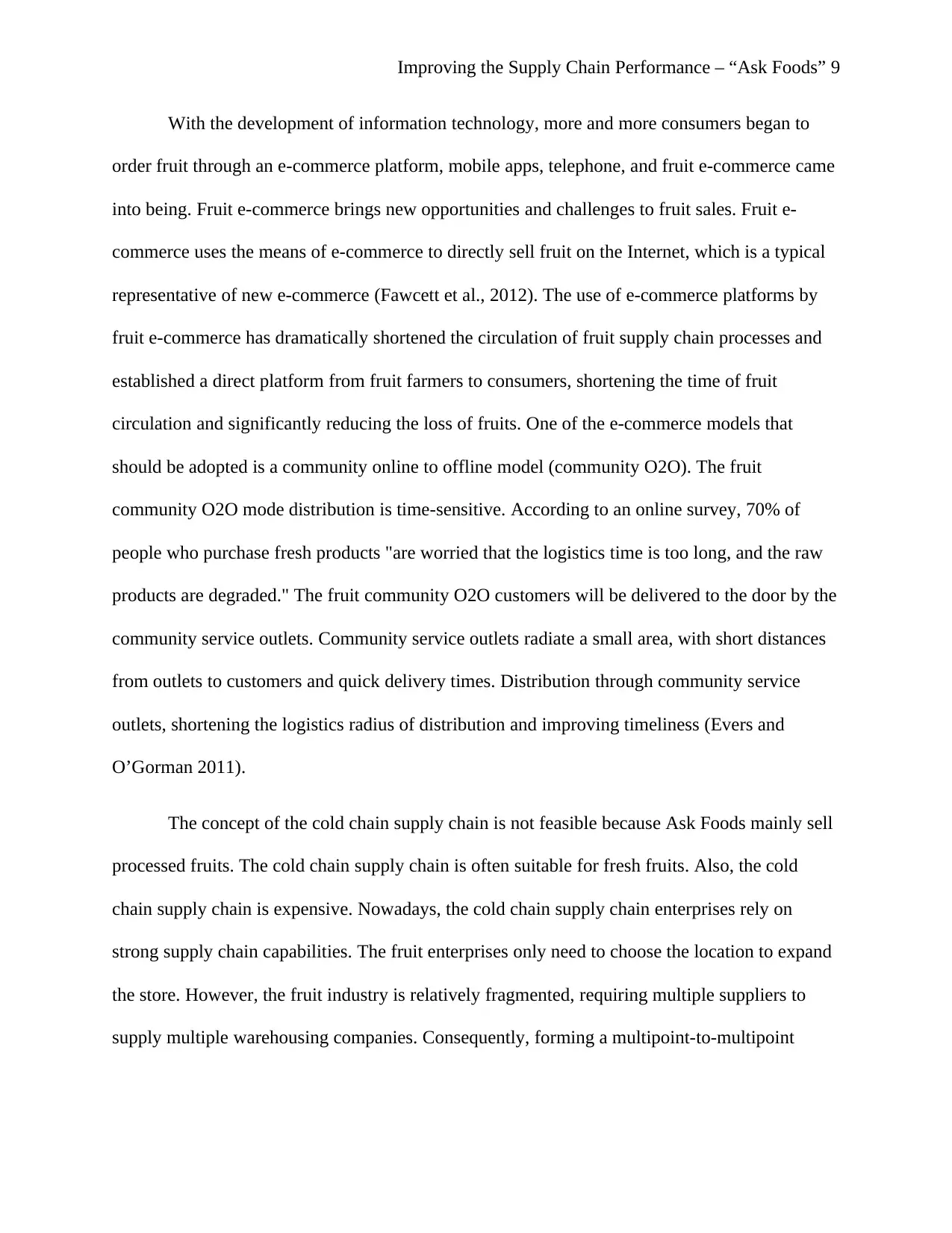
Improving the Supply Chain Performance – “Ask Foods” 9
With the development of information technology, more and more consumers began to
order fruit through an e-commerce platform, mobile apps, telephone, and fruit e-commerce came
into being. Fruit e-commerce brings new opportunities and challenges to fruit sales. Fruit e-
commerce uses the means of e-commerce to directly sell fruit on the Internet, which is a typical
representative of new e-commerce (Fawcett et al., 2012). The use of e-commerce platforms by
fruit e-commerce has dramatically shortened the circulation of fruit supply chain processes and
established a direct platform from fruit farmers to consumers, shortening the time of fruit
circulation and significantly reducing the loss of fruits. One of the e-commerce models that
should be adopted is a community online to offline model (community O2O). The fruit
community O2O mode distribution is time-sensitive. According to an online survey, 70% of
people who purchase fresh products "are worried that the logistics time is too long, and the raw
products are degraded." The fruit community O2O customers will be delivered to the door by the
community service outlets. Community service outlets radiate a small area, with short distances
from outlets to customers and quick delivery times. Distribution through community service
outlets, shortening the logistics radius of distribution and improving timeliness (Evers and
O’Gorman 2011).
The concept of the cold chain supply chain is not feasible because Ask Foods mainly sell
processed fruits. The cold chain supply chain is often suitable for fresh fruits. Also, the cold
chain supply chain is expensive. Nowadays, the cold chain supply chain enterprises rely on
strong supply chain capabilities. The fruit enterprises only need to choose the location to expand
the store. However, the fruit industry is relatively fragmented, requiring multiple suppliers to
supply multiple warehousing companies. Consequently, forming a multipoint-to-multipoint
With the development of information technology, more and more consumers began to
order fruit through an e-commerce platform, mobile apps, telephone, and fruit e-commerce came
into being. Fruit e-commerce brings new opportunities and challenges to fruit sales. Fruit e-
commerce uses the means of e-commerce to directly sell fruit on the Internet, which is a typical
representative of new e-commerce (Fawcett et al., 2012). The use of e-commerce platforms by
fruit e-commerce has dramatically shortened the circulation of fruit supply chain processes and
established a direct platform from fruit farmers to consumers, shortening the time of fruit
circulation and significantly reducing the loss of fruits. One of the e-commerce models that
should be adopted is a community online to offline model (community O2O). The fruit
community O2O mode distribution is time-sensitive. According to an online survey, 70% of
people who purchase fresh products "are worried that the logistics time is too long, and the raw
products are degraded." The fruit community O2O customers will be delivered to the door by the
community service outlets. Community service outlets radiate a small area, with short distances
from outlets to customers and quick delivery times. Distribution through community service
outlets, shortening the logistics radius of distribution and improving timeliness (Evers and
O’Gorman 2011).
The concept of the cold chain supply chain is not feasible because Ask Foods mainly sell
processed fruits. The cold chain supply chain is often suitable for fresh fruits. Also, the cold
chain supply chain is expensive. Nowadays, the cold chain supply chain enterprises rely on
strong supply chain capabilities. The fruit enterprises only need to choose the location to expand
the store. However, the fruit industry is relatively fragmented, requiring multiple suppliers to
supply multiple warehousing companies. Consequently, forming a multipoint-to-multipoint
⊘ This is a preview!⊘
Do you want full access?
Subscribe today to unlock all pages.

Trusted by 1+ million students worldwide
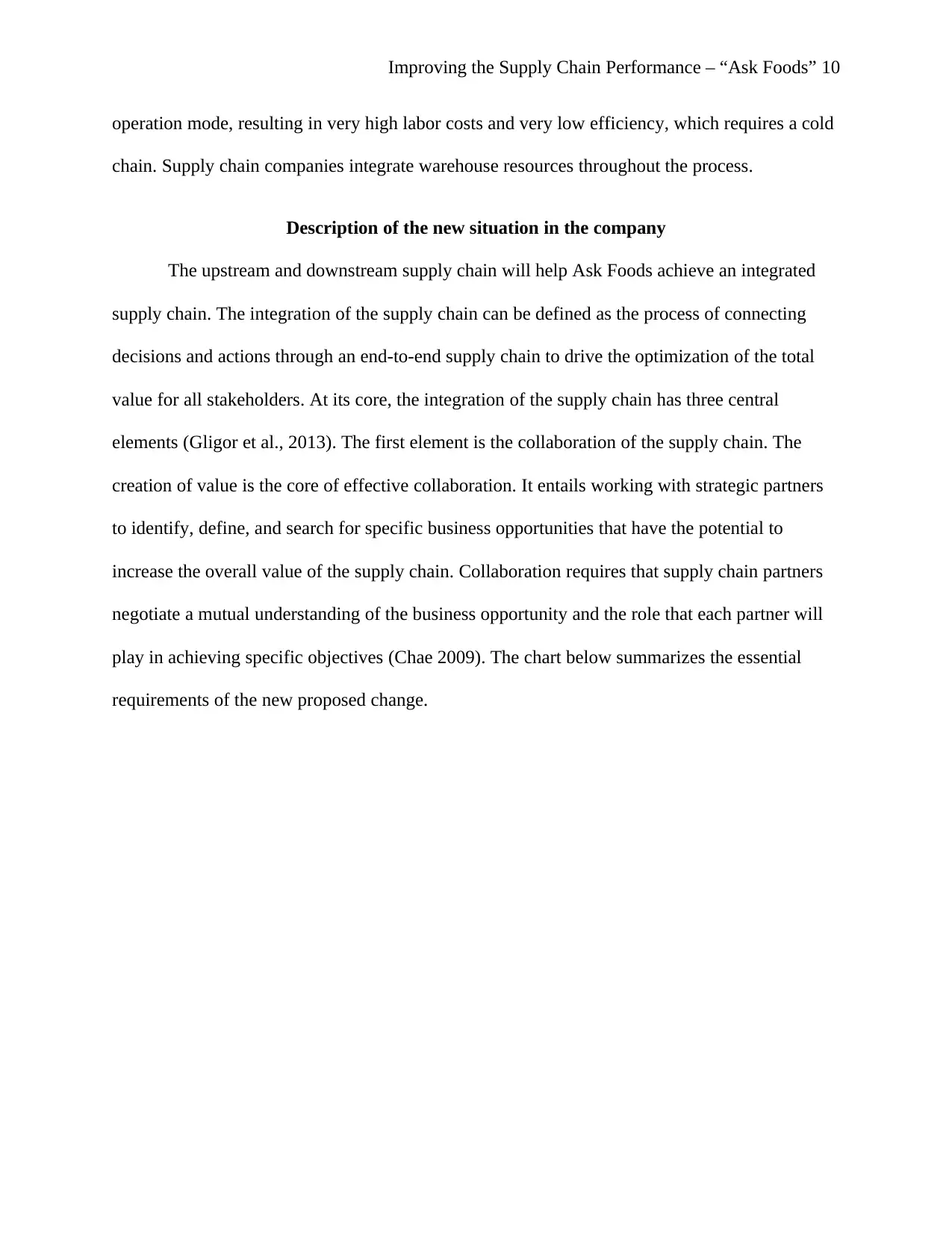
Improving the Supply Chain Performance – “Ask Foods” 10
operation mode, resulting in very high labor costs and very low efficiency, which requires a cold
chain. Supply chain companies integrate warehouse resources throughout the process.
Description of the new situation in the company
The upstream and downstream supply chain will help Ask Foods achieve an integrated
supply chain. The integration of the supply chain can be defined as the process of connecting
decisions and actions through an end-to-end supply chain to drive the optimization of the total
value for all stakeholders. At its core, the integration of the supply chain has three central
elements (Gligor et al., 2013). The first element is the collaboration of the supply chain. The
creation of value is the core of effective collaboration. It entails working with strategic partners
to identify, define, and search for specific business opportunities that have the potential to
increase the overall value of the supply chain. Collaboration requires that supply chain partners
negotiate a mutual understanding of the business opportunity and the role that each partner will
play in achieving specific objectives (Chae 2009). The chart below summarizes the essential
requirements of the new proposed change.
operation mode, resulting in very high labor costs and very low efficiency, which requires a cold
chain. Supply chain companies integrate warehouse resources throughout the process.
Description of the new situation in the company
The upstream and downstream supply chain will help Ask Foods achieve an integrated
supply chain. The integration of the supply chain can be defined as the process of connecting
decisions and actions through an end-to-end supply chain to drive the optimization of the total
value for all stakeholders. At its core, the integration of the supply chain has three central
elements (Gligor et al., 2013). The first element is the collaboration of the supply chain. The
creation of value is the core of effective collaboration. It entails working with strategic partners
to identify, define, and search for specific business opportunities that have the potential to
increase the overall value of the supply chain. Collaboration requires that supply chain partners
negotiate a mutual understanding of the business opportunity and the role that each partner will
play in achieving specific objectives (Chae 2009). The chart below summarizes the essential
requirements of the new proposed change.
Paraphrase This Document
Need a fresh take? Get an instant paraphrase of this document with our AI Paraphraser
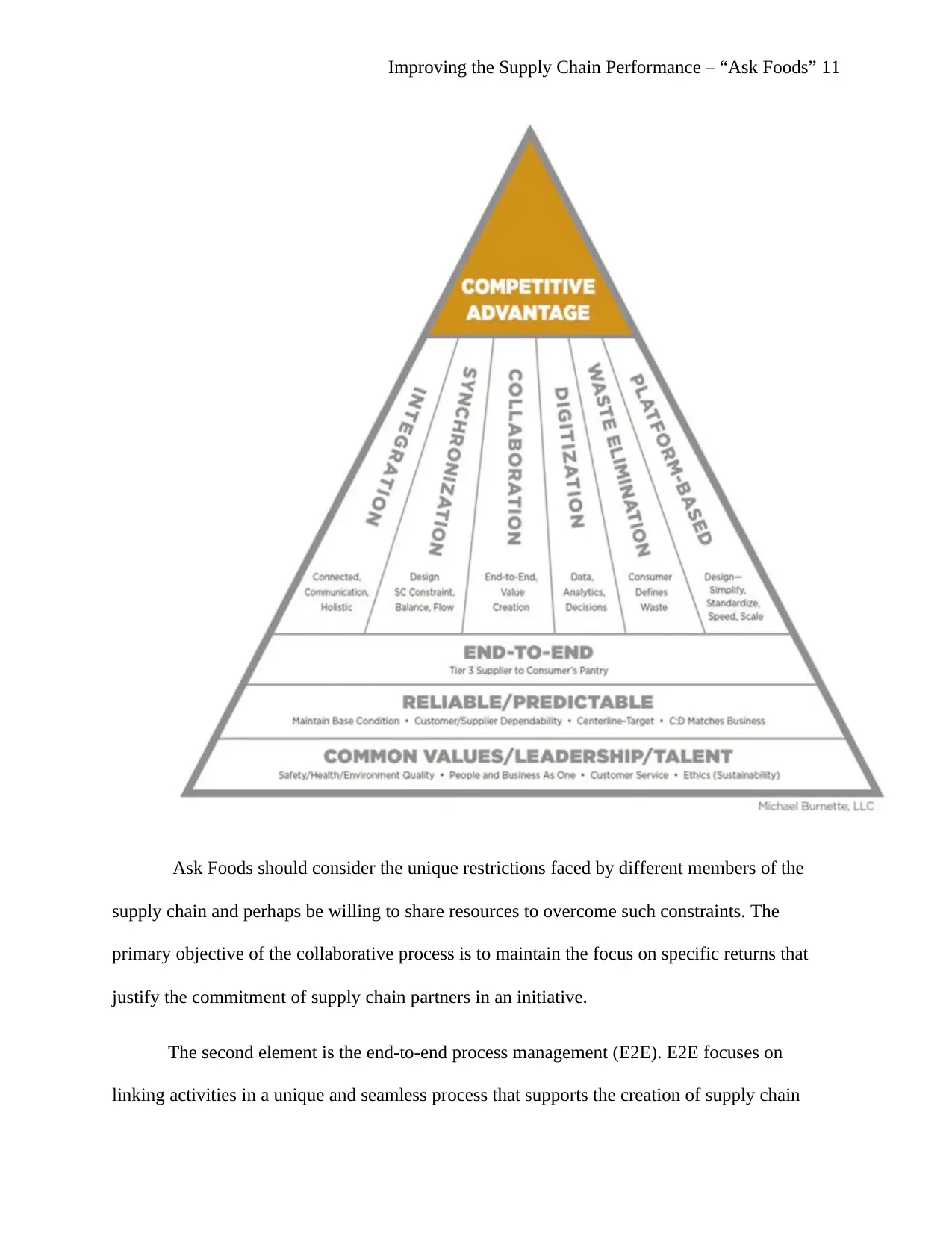
Improving the Supply Chain Performance – “Ask Foods” 11
Ask Foods should consider the unique restrictions faced by different members of the
supply chain and perhaps be willing to share resources to overcome such constraints. The
primary objective of the collaborative process is to maintain the focus on specific returns that
justify the commitment of supply chain partners in an initiative.
The second element is the end-to-end process management (E2E). E2E focuses on
linking activities in a unique and seamless process that supports the creation of supply chain
Ask Foods should consider the unique restrictions faced by different members of the
supply chain and perhaps be willing to share resources to overcome such constraints. The
primary objective of the collaborative process is to maintain the focus on specific returns that
justify the commitment of supply chain partners in an initiative.
The second element is the end-to-end process management (E2E). E2E focuses on
linking activities in a unique and seamless process that supports the creation of supply chain
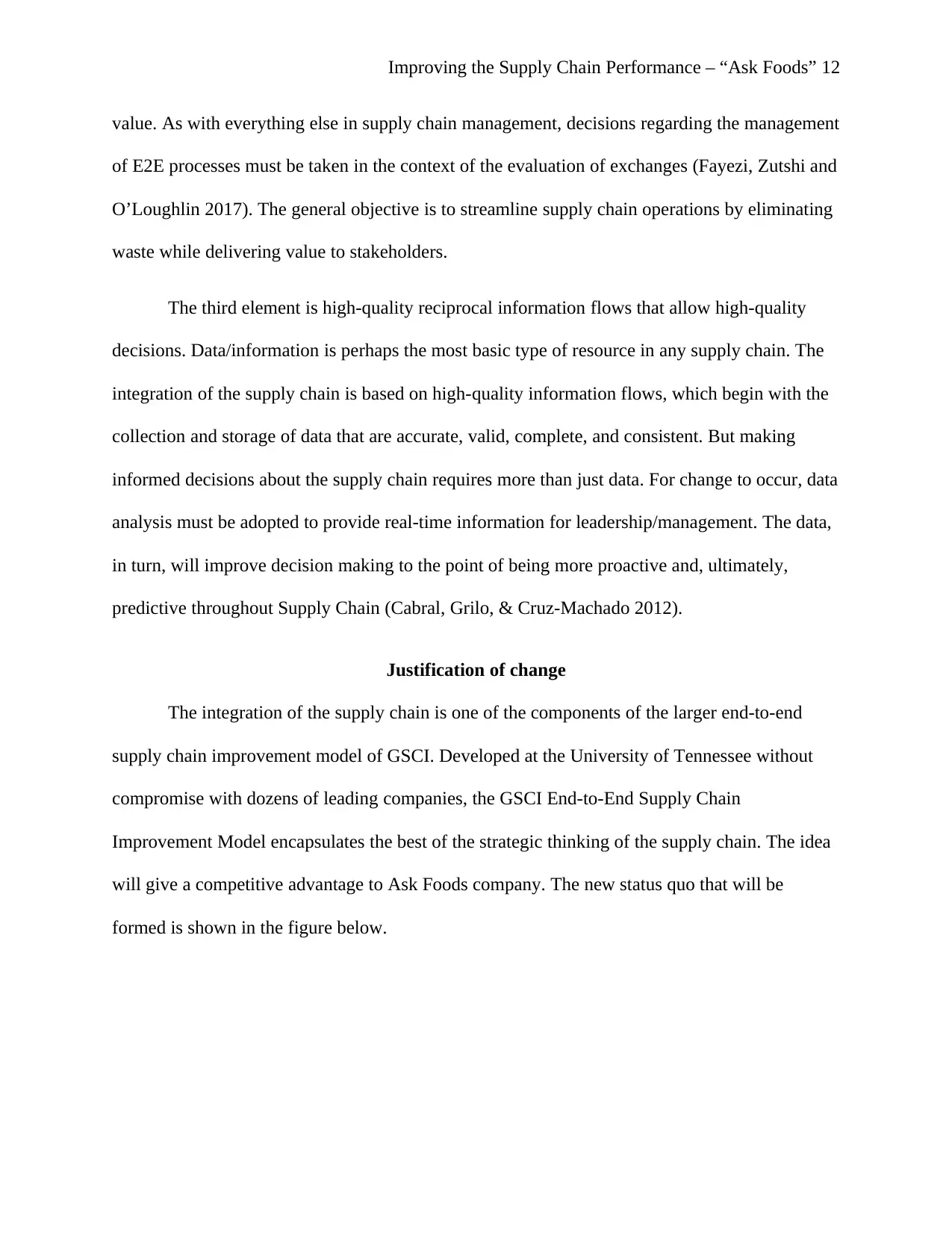
Improving the Supply Chain Performance – “Ask Foods” 12
value. As with everything else in supply chain management, decisions regarding the management
of E2E processes must be taken in the context of the evaluation of exchanges (Fayezi, Zutshi and
O’Loughlin 2017). The general objective is to streamline supply chain operations by eliminating
waste while delivering value to stakeholders.
The third element is high-quality reciprocal information flows that allow high-quality
decisions. Data/information is perhaps the most basic type of resource in any supply chain. The
integration of the supply chain is based on high-quality information flows, which begin with the
collection and storage of data that are accurate, valid, complete, and consistent. But making
informed decisions about the supply chain requires more than just data. For change to occur, data
analysis must be adopted to provide real-time information for leadership/management. The data,
in turn, will improve decision making to the point of being more proactive and, ultimately,
predictive throughout Supply Chain (Cabral, Grilo, & Cruz-Machado 2012).
Justification of change
The integration of the supply chain is one of the components of the larger end-to-end
supply chain improvement model of GSCI. Developed at the University of Tennessee without
compromise with dozens of leading companies, the GSCI End-to-End Supply Chain
Improvement Model encapsulates the best of the strategic thinking of the supply chain. The idea
will give a competitive advantage to Ask Foods company. The new status quo that will be
formed is shown in the figure below.
value. As with everything else in supply chain management, decisions regarding the management
of E2E processes must be taken in the context of the evaluation of exchanges (Fayezi, Zutshi and
O’Loughlin 2017). The general objective is to streamline supply chain operations by eliminating
waste while delivering value to stakeholders.
The third element is high-quality reciprocal information flows that allow high-quality
decisions. Data/information is perhaps the most basic type of resource in any supply chain. The
integration of the supply chain is based on high-quality information flows, which begin with the
collection and storage of data that are accurate, valid, complete, and consistent. But making
informed decisions about the supply chain requires more than just data. For change to occur, data
analysis must be adopted to provide real-time information for leadership/management. The data,
in turn, will improve decision making to the point of being more proactive and, ultimately,
predictive throughout Supply Chain (Cabral, Grilo, & Cruz-Machado 2012).
Justification of change
The integration of the supply chain is one of the components of the larger end-to-end
supply chain improvement model of GSCI. Developed at the University of Tennessee without
compromise with dozens of leading companies, the GSCI End-to-End Supply Chain
Improvement Model encapsulates the best of the strategic thinking of the supply chain. The idea
will give a competitive advantage to Ask Foods company. The new status quo that will be
formed is shown in the figure below.
⊘ This is a preview!⊘
Do you want full access?
Subscribe today to unlock all pages.

Trusted by 1+ million students worldwide
1 out of 20
Related Documents
Your All-in-One AI-Powered Toolkit for Academic Success.
+13062052269
info@desklib.com
Available 24*7 on WhatsApp / Email
![[object Object]](/_next/static/media/star-bottom.7253800d.svg)
Unlock your academic potential
Copyright © 2020–2025 A2Z Services. All Rights Reserved. Developed and managed by ZUCOL.





